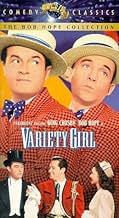IMDb-BEWERTUNG
6,3/10
525
IHRE BEWERTUNG
Füge eine Handlung in deiner Sprache hinzuAlmost everyone under contract to Paramount Pictures at the time make cameos or perform songs, with particularly large amounts of screen time featuring Bob Hope and Bing Crosby.Almost everyone under contract to Paramount Pictures at the time make cameos or perform songs, with particularly large amounts of screen time featuring Bob Hope and Bing Crosby.Almost everyone under contract to Paramount Pictures at the time make cameos or perform songs, with particularly large amounts of screen time featuring Bob Hope and Bing Crosby.
Handlung
WUSSTEST DU SCHON:
- WissenswertesUnder contract to different record labels at the time - Bing Crosby at Decca and Bob Hope at Capitol - the duo could not produce for the marketplace a disc of their specialty number from the film, "Harmony" (music by Jimmy Van Heusen, lyrics by Johnny Burke). Decca, taking another tune from the score, united Bing with his frequent recording partners, The Andrews Sisters, for a best-selling single of the jaunty city song, "Tallahassee" (music and lyrics by Frank Loesser), a ditty introduced in the picture by Dorothy Lamour and the usually non-singing Alan Ladd. On a Capitol 78, Johnny Mercer teamed with The King Cole Trio for their take on "Harmony."
- Zitate
Bing Crosby: Go away, or I'll beat you to a pulp with my Oscar.
- Alternative VersionenAlthough the George Pal Puppetoon sequence was originally presented in Technicolor, most extant prints of "Variety Girl" now show this segment in black-and-white.
- VerbindungenReferenced in Flesh (1968)
- SoundtracksYour Heart Calling Mine
Written by Frank Loesser
Sung by Mary Hatcher with Spike Jones and His Orchestra
Ausgewählte Rezension
This movie is a rollicking treat in so many ways.
Firstly it is a wonderful nostalgic trip around Paramount studios in 1947. Bing's makeshift golf course, sound stages and administration buildings.
It is also an insight into how pictures were made. In the Cecil B. DeMille scene set there is of course no blue/green screen. The projection light goes on, and suddenly you see the back projection of the river. And when the actress walks behind the screen you see her shadow looming prominently. Or in William Bendix's kitchen where you see the sink is simply a board with nothing underneath, and the actor runs out of a back door discretely hidden in the scenery.
Even the backstory used as a link to the stars is entertaining. Frank Ferguson with his distinct gravelly voice, who generally plays small parts such as the townsman in westerns who gets shot after about 5 minutes, gives his all as the studio head, Olga San Juan's performance isn't too forced and De Forrest Kelley is a curiosity in a rare leading (sort of) nice guy role. But of course the crowd wants to see the stars. And boy do they shine. Hope & Crosby's golf skit, Alan Ladd in a singing role with Dorothy Lamour, even Pinto Colvig (best known as the voice of Grumpy & the first voice of Goofy) in performance doing voice over.
Sadly the print I saw (Universal Vault DVD series)has the Puppetoon sequence in black and white (even though the credits say it's in color).
Apart from that frustrating issue, in summing up, just relax and soak up the fun.
Firstly it is a wonderful nostalgic trip around Paramount studios in 1947. Bing's makeshift golf course, sound stages and administration buildings.
It is also an insight into how pictures were made. In the Cecil B. DeMille scene set there is of course no blue/green screen. The projection light goes on, and suddenly you see the back projection of the river. And when the actress walks behind the screen you see her shadow looming prominently. Or in William Bendix's kitchen where you see the sink is simply a board with nothing underneath, and the actor runs out of a back door discretely hidden in the scenery.
Even the backstory used as a link to the stars is entertaining. Frank Ferguson with his distinct gravelly voice, who generally plays small parts such as the townsman in westerns who gets shot after about 5 minutes, gives his all as the studio head, Olga San Juan's performance isn't too forced and De Forrest Kelley is a curiosity in a rare leading (sort of) nice guy role. But of course the crowd wants to see the stars. And boy do they shine. Hope & Crosby's golf skit, Alan Ladd in a singing role with Dorothy Lamour, even Pinto Colvig (best known as the voice of Grumpy & the first voice of Goofy) in performance doing voice over.
Sadly the print I saw (Universal Vault DVD series)has the Puppetoon sequence in black and white (even though the credits say it's in color).
Apart from that frustrating issue, in summing up, just relax and soak up the fun.
Top-Auswahl
Melde dich zum Bewerten an und greife auf die Watchlist für personalisierte Empfehlungen zu.
- How long is Variety Girl?Powered by Alexa
Details
- Erscheinungsdatum
- Herkunftsland
- Sprache
- Auch bekannt als
- Variety Girl
- Drehorte
- Produktionsfirma
- Weitere beteiligte Unternehmen bei IMDbPro anzeigen
- Laufzeit1 Stunde 33 Minuten
- Farbe
- Seitenverhältnis
- 1.37 : 1
Zu dieser Seite beitragen
Bearbeitung vorschlagen oder fehlenden Inhalt hinzufügen

Oberste Lücke
By what name was Mädchen für Hollywood (1947) officially released in India in English?
Antwort



































